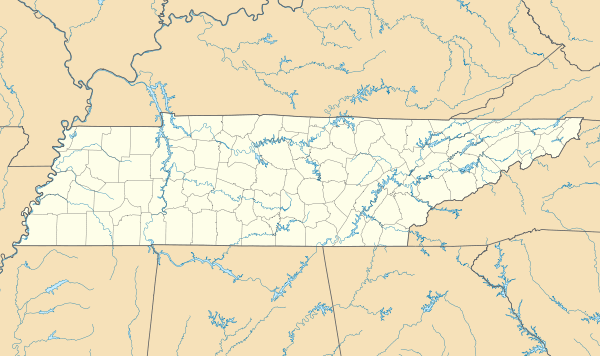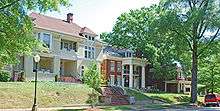Fort Wood Historic District
|
Fort Wood Historic District | |
|
Fort Wood District looking down Oak Street | |
  | |
| Location |
Roughly bounded by Palmetto, McCallie, E. 4th St and O'Neal St Chattanooga, Tennessee |
|---|---|
| Coordinates | 35°02′41″N 85°17′31″W / 35.0448°N 85.2920°WCoordinates: 35°02′41″N 85°17′31″W / 35.0448°N 85.2920°W |
| NRHP Reference # | 79002437 |
| Added to NRHP | April 18, 1979 |
The Fort Wood National Historic District is a historic neighborhood in Chattanooga, Tennessee. On April 17, 1979, Fort Wood Historic District became certified by the National Park Service as a national historic site. It is bounded roughly by Palmetto Street, McCallie Avenue, East 4th Street, and O'Neal Street, and located just east of the University of Tennessee at Chattanooga campus.
History

A fortification during the Civil War, Fort Wood was constructed by Union Army in 1863. The National Park Service has placed several war-era cannons in the neighborhood.[1] In the 1880s, the fort and surrounding land was auctioned off. In time, Fort Wood became one of Chattanooga's finest residential neighborhoods. Large, fashionable homes soon appeared in the Queen Anne, Tudor Revival, and Romanesque Revival styles.
White flight took its toll on the neighborhood, starting in the 1950s. Residents relocated to suburbs like Signal Mountain, Hixson, and East Brainerd. By the 1970s, the neighborhood's situation was critical. Many of the buildings in and around Fort Wood had fallen into disrepair or had become victims of vandalism or arson. The neighborhood's bad reputation began to affect the students of nearby UT Chattanooga, many of whom moved off campus and stopped enrolling in evening classes.
Fort Wood's revitalization began with the Warner House at the corner of Vine and Palmetto Streets. Also, the City council gave the Fort Wood area statutory zoning protection and many more houses were under renovation. Today, many of the homes in Fort Wood have been converted into apartments. Indeed, student apartments in this area are highly sought after by UTC students who wish to live off, but close to, the campus.

Notable structures
- Warner House (1891)
- William Gibbs McAdoo house (1888)
- Fort Wood Apartments (1904)
- Sigma Chi Fraternity house was located at 901 Oak St. before it burned down in 1998
- Kappa Sigma Fraternity House (1903)
- Mizpah Congregation synagogue (c. 1928)
- 926 Oak Street Lambda Chi Alpha Fraternity House (1909)
- Z.C. Patten House (1892) – Known to most UTC students as "Patten House," home of the Alumni Affairs Department. Also notable are the two Civil War-era cannon on the front lawn.
- 900 Oak St, once a fraternity house,[2] it now houses a Twelve Tribes Community[3]
Mayor Edmund Watkins House, 801 Vine Street. Built in 1889, now operated as the Mayor's Mansion Inn Bed and Breakfast.
References
- ↑ http://www.historicfortwood.org/index.php?/custom/article/about/
- ↑ UT Chattanooga. "UTC Student Handbook Online" (PDF). UT Chattanooga. Retrieved 2009-12-12.
- ↑ Twelve Tribes. "Twelve Tribes Community in Chattanooga". Intentional Communities. Intentional Communities. Retrieved 2009-12-12.
External links
- Cornerstones, Inc., page about Fort Wood area
- Article regarding the clash between college students and older residents
- Chattanooga Department of Neighborhood Services
- Site giving information from the National Register of Historic Places
